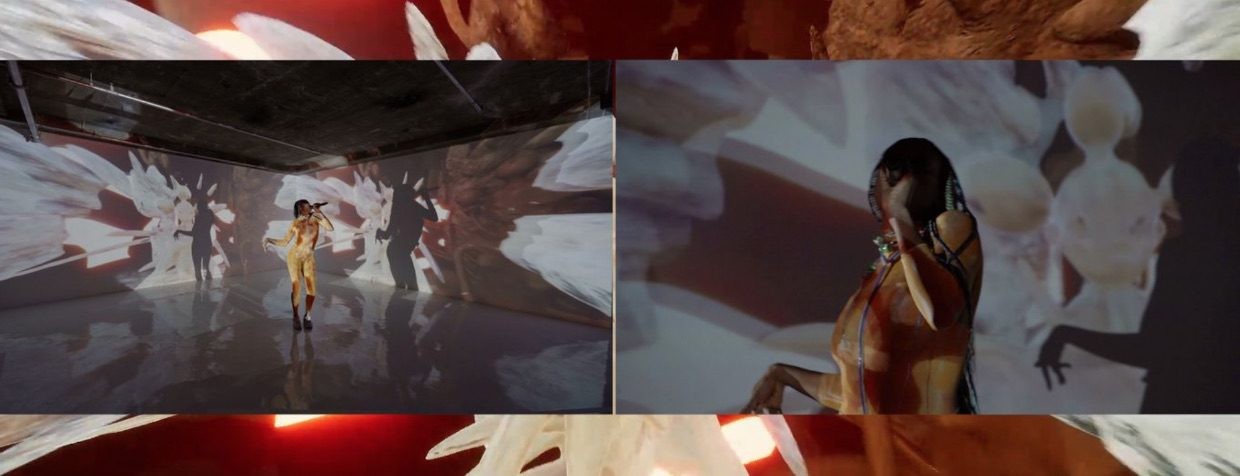Do Androids Dream of Being Black?

02 December 2021
Magazine C& Magazine
Words Liese Van Der Watt
5 min read
Our author Liese Van Der Watt went to the exhibition that creates sonic and visual landscapes for Black futurism.
Back in May 2020 when the UK was in the midst of its first lockdown and most people were getting antsy, angsty, lazy, or all three at the same time, cultural entrepreneurs and music artists Gaika, GLOR1A, and Shannen SP formed the collective Nine Nights, aiming “to counter the systemic racial inequalities of the global music industry by exploring new modes of artistic empowerment.” They wanted to build an infrastructure and an ecosystem to support and develop Black culture.
Channel B, currently at the ICA in London, is one node within this ecosystem. It is an exhibition of five sound and video installations that are spaces and stages for what Nine Nights, and their collaborator Zara Truss-Giles, call “activations” – live events that take place throughout the exhibition’s run, ranging from art and music performances to dance and synth workshops. Entitled “New Syntax,” this series of live events is meant to attract a wider audience into the gallery, challenging the elitism that affects many art institutions.

NINE NIGHTS at ICA London. Photo credit © Anne Tetzlaff
It’s a wonderful concept that brings fluidity into that staid and usually one-directional triad of exhibition–curator–artist/artwork; it encourages us to abandon the certainties of originators and artworks and embrace the notion of collective work. On the Thursday night I was there, expecting an activation according to the program but told by reception that nothing was planned, I found dancers and actors from Central Hype Entertainment practicing a routine they will be showing later in the month. They had just come in from Trafalgar Square where they often perform, and were now congregating on a small stage in the middle of SWARM, a “performance space and ideation hub” conceptualized by GLOR1A as a “secret cavern where dream-states can live, developed to house an alien from prying eyes.” I watched them, carried by the beats and their insanely fluid bodies. They had taken up GLOR1A’s offer to use the space, which then made sense as an inclusive, enabling place where ideas develop and artists clearly support one another in making art.

NINE NIGHTS at ICA London. Photo credit © Anne Tetzlaff
One question to be asked of any exhibition containing live performance is how to approach it when its spaces are not activated. This exhibition is billed as an exploration of Black futurism: the ICA blurb explains that the title, Channel B, is a reference to a “rogue frequency” that operates “beyond history, place and time” as an infiltrating force, a counterculture that imagines a different future differently, embedded in a technologically enabling world. This is classic Afrofuturism, dreaming and imagining of a Black future, and from the moment I entered the exhibition space I was viscerally aware of a transporting soundscape that dominates every room, complemented by technology in various forms. But the spaces felt also strangely empty, waiting for and haunted by the ghosts of performances that would develop them and make them breathe.

NINE NIGHTS_ICA_Photo credit © Anne Tetzlaff-6507
Gaika has created a sculptural installation, installed in sound and containing empty server-type towers, shapes echoed by imagery of city tower blocks. Entitled War Island, the work is a meditation on the architecture of gentrification, a concept rich with potential, and a poetic text on the wall, written collectively, summons up “towers [that] gleam out of the dark … the gardens contain our memories / hot days at city parks / bikes and barbeques, it’s anthemic …” It is strikingly thought-provoking, yet when seen without its intended activations and live acts it was too sparsely executed to really engage me. The city returns in Gaika’s second installation, Ca$h Fractals, moving images of London at night set to transporting, rushing sound and probably the most emotive of the environments created for Channel B.

NINE NIGHTS at ICA London. Photo credit © Anne Tetzlaff
Zen Projects LTD, presented by ShannenSP, is a satirical dystopian wellness environment: a futuristic interior, created in collaboration with Kumbirai Makumbe, screens moving image works by Black artists to an audience sat on massage chairs. The collective Black Obsidian Sound System, nominated for the Turner Prize in 2021, presents one of the meditating sound landscapes for this room, with a variety of looped imagery such as a hypnotic Manwigs Commercial, centering the queer experience that stand central to the collective as a whole. I found the installation effective as a contained, self-fulfilling environment, but I would have liked more information about it.

NINE NIGHTS at ICA London. Photo credit © Anne Tetzlaff
Channel B is interesting as an experience situated between the more conventional visual form of the art institution and the infiltrating sonic landscapes that Nine Nights and various other collectives develop. That experience could feel somewhat unintegrated: in order to concentrate on the richly evocative poems on the walls I had to zone out the sound, at other times I felt the sound could have done with more visual interest. But when the two come together, when sound and visual imagery balance each other as it largely does in Gaika’s Ca$h Fractals and probably would during the exhibition’s activations, there is indeed a sense of being on the brink of something, of experiencing a new economy and the possibility of imagining a collective future.
Nine Nights: Channel B runs through 30 January 2022 at ICA London.
Based in London, Liese Van Der Watt is a South African art historian and writer.
Read more from

‘Apprendre à Flamboyer’: Collective Joy in Practice at Palais de Tokyo

C& Magazine’s Highlights of 2023 You Might Want to Read Again

John Akomfrah: “If there is a problem with hybridity, for me, it is that it participates in this hierarchization of the world”
Read more from

Caribbean Sounds: The Connective Possibilities of Radio

Caribbean Sounds: The Connective Possibilities of Radio
